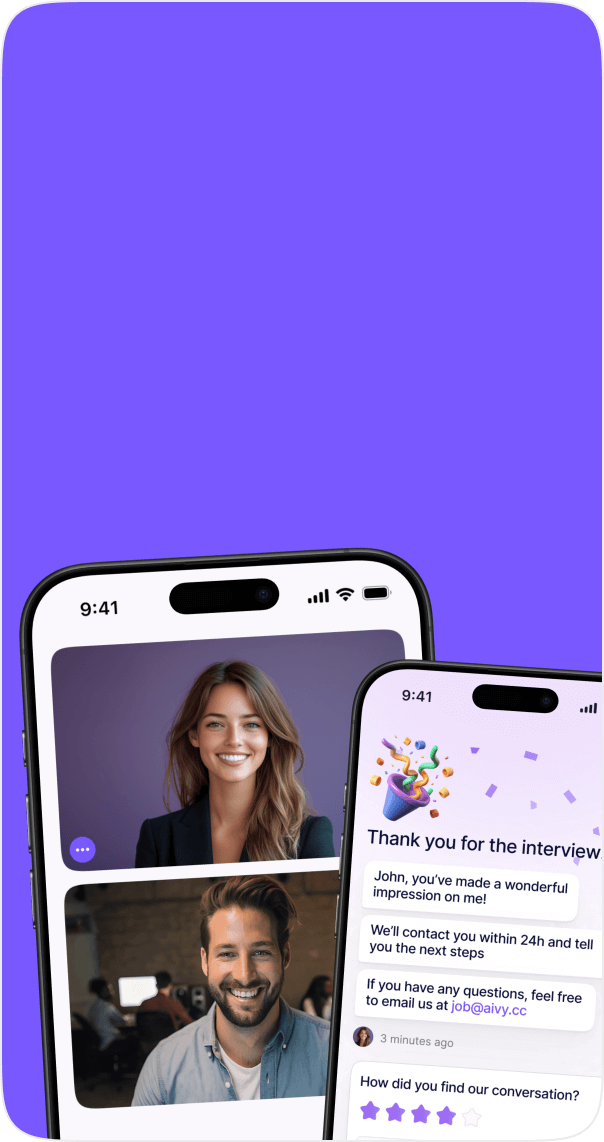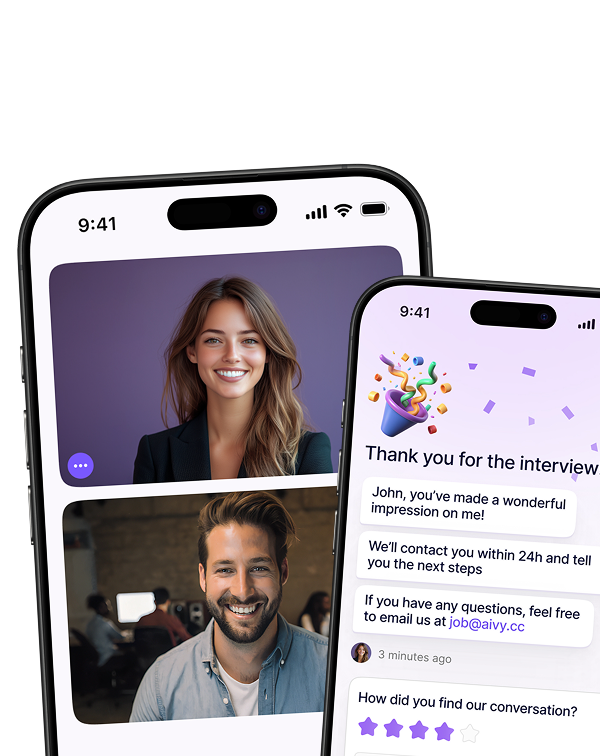Apr. 2, 2025
Why using AI in hiring is actually the more human approach
In today's competitive talent market, many HR departments pride themselves on maintaining a "human touch" throughout their hiring process. This approach, while well-intentioned, deserves closer examination. Recent data suggests that an over-reliance on manual candidate screening may actually be counterproductive for both companies and candidates. Let's discuss why.
The real cost of manual screening
According to LinkedIn's January 2025 "Work Change report", 22% of HR professionals spend 3-5 hours daily reviewing applications manually. This represents a substantial commitment of resources that affects the bottom line.
For a typical mid-sized company, the numbers are revealing:
More concerning is Fortune's finding that 73% of these applications don't meet basic position criteria. This means recruiters invest significant time reviewing candidates who aren't qualified for the role - time that could be directed toward more meaningful candidate interactions.
When good intentions lead to poor outcomes
The belief that every application deserves human review stems from admirable intentions. However, this approach often creates the opposite of its intended effect.
When recruiters are overwhelmed by volume, their ability to provide quality attention diminishes significantly. After reviewing dozens of applications, cognitive fatigue sets in, and decision quality inevitably suffers. The result is a process that appears personal but delivers an impersonal experience.
The bias paradox
Perhaps the most surprising aspect of manual screening is that it often introduces more bias than automated alternatives. Human recruiters, despite best efforts, are susceptible to unconscious biases that affect judgment:
This creates an uncomfortable reality: the "human touch" we believe provides fair consideration may actually introduce inconsistency into the process.
A better way forward
The solution isn't eliminating human judgment from hiring - it's applying it more strategically. Companies that have implemented partial automation report significant benefits, and the data supports it. LinkedIn reports that 51% of businesses using AI in their processes saw revenue increases of 10% or more. Meanwhile, AI-assisted messages receive 11% faster candidate responses than traditional communications.
Best positions to deploy AI in hiring
For entry-level positions, where application volumes are highest and credential differences smallest, automation offers particular advantages. Traditional screening methods struggle with these roles because:
Most surprisingly, candidates may find these processes more responsive and fair because they receive faster feedback and feel less nervous when interacting with AI.
The economics of efficiency
Consider the resource allocation difference:
With manual screening, reviewing 100 applications takes approximately 25 hours (15 minutes per application) at a cost of around $750 in recruiter time. Using technology-assisted screening, the same 100 applications require about 30 minutes of human oversight, costing roughly $15.
This not only saves money, but also allows human attention to be reallocated to where it does the most good. When recruiters spend less time on initial screening, they can invest more in meaningful candidate interactions, hiring manager consultations, and strategic recruitment planning.
Improving the candidate experience
Perhaps counterintuitively, partial automation can create a more human experience for candidates. When 73% of applications don't meet basic requirements, manual review processes mean qualified candidates wait longer for responses while recruiters sift through unqualified applications. But what about the companies?
We believe that the most successful organizations are those who find a thoughtful balance between technology and human interaction. Rather than viewing it as an either/or proposition, it's better to create a processes where each plays to its strengths:
The result is a process that's more efficient for companies and more responsive for candidates - a genuine win-win.
Moving forward mindfully
As you consider your own recruitment processes, the question isn't whether to maintain a human element, but rather how to apply human judgment where it adds the most value.
Ask yourself:
In today's hiring landscape, the most human approach may not be having humans handle every step of the process. Instead, it may be thoughtfully applying technology to enhance the human experience for everyone involved.
Data referenced in this article comes from LinkedIn's January 2025 "Work Change Report" and Fortune's January 15, 2025 analysis "Labor mismatch: Why HR leaders are finding fewer qualified job candidates amid a flood of applications."
In today's competitive talent market, many HR departments pride themselves on maintaining a "human touch" throughout their hiring process. This approach, while well-intentioned, deserves closer examination. Recent data suggests that an over-reliance on manual candidate screening may actually be counterproductive for both companies and candidates. Let's discuss why.
The real cost of manual screening
According to LinkedIn's January 2025 "Work Change report", 22% of HR professionals spend 3-5 hours daily reviewing applications manually. This represents a substantial commitment of resources that affects the bottom line.
For a typical mid-sized company, the numbers are revealing:
- A recruiter spending 15-25 hours weekly on manual screening.
- At a $60K annual salary, this translates to $450-750 weekly per recruiter.
- For a team of five recruiters, the annual cost ranges from $117,000 to $195,000.
More concerning is Fortune's finding that 73% of these applications don't meet basic position criteria. This means recruiters invest significant time reviewing candidates who aren't qualified for the role - time that could be directed toward more meaningful candidate interactions.
When good intentions lead to poor outcomes
The belief that every application deserves human review stems from admirable intentions. However, this approach often creates the opposite of its intended effect.
When recruiters are overwhelmed by volume, their ability to provide quality attention diminishes significantly. After reviewing dozens of applications, cognitive fatigue sets in, and decision quality inevitably suffers. The result is a process that appears personal but delivers an impersonal experience.
The bias paradox
Perhaps the most surprising aspect of manual screening is that it often introduces more bias than automated alternatives. Human recruiters, despite best efforts, are susceptible to unconscious biases that affect judgment:
- We naturally favor candidates who remind us of ourselves.
- Early impressions disproportionately influence our overall assessment.
- By day's end, decision quality declines as intelligent resources deplete.
This creates an uncomfortable reality: the "human touch" we believe provides fair consideration may actually introduce inconsistency into the process.
A better way forward
The solution isn't eliminating human judgment from hiring - it's applying it more strategically. Companies that have implemented partial automation report significant benefits, and the data supports it. LinkedIn reports that 51% of businesses using AI in their processes saw revenue increases of 10% or more. Meanwhile, AI-assisted messages receive 11% faster candidate responses than traditional communications.
Best positions to deploy AI in hiring
For entry-level positions, where application volumes are highest and credential differences smallest, automation offers particular advantages. Traditional screening methods struggle with these roles because:
- The volume-to-quality ratio is challenging to manage manually.
- Resume credentials poorly predict on-the-job performance for early-career roles.
- Maintaining consistent evaluation criteria across hundreds of similar applications is nearly impossible.
Most surprisingly, candidates may find these processes more responsive and fair because they receive faster feedback and feel less nervous when interacting with AI.
The economics of efficiency
Consider the resource allocation difference:
With manual screening, reviewing 100 applications takes approximately 25 hours (15 minutes per application) at a cost of around $750 in recruiter time. Using technology-assisted screening, the same 100 applications require about 30 minutes of human oversight, costing roughly $15.
This not only saves money, but also allows human attention to be reallocated to where it does the most good. When recruiters spend less time on initial screening, they can invest more in meaningful candidate interactions, hiring manager consultations, and strategic recruitment planning.
Improving the candidate experience
Perhaps counterintuitively, partial automation can create a more human experience for candidates. When 73% of applications don't meet basic requirements, manual review processes mean qualified candidates wait longer for responses while recruiters sift through unqualified applications. But what about the companies?
We believe that the most successful organizations are those who find a thoughtful balance between technology and human interaction. Rather than viewing it as an either/or proposition, it's better to create a processes where each plays to its strengths:
- Automated systems handle initial screening based on objective requirements.
- AI-assisted preliminary interviews standardize early assessments.
- Human recruiters focus on nuanced evaluations, cultural fit, and candidate relationship building.
The result is a process that's more efficient for companies and more responsive for candidates - a genuine win-win.
Moving forward mindfully
As you consider your own recruitment processes, the question isn't whether to maintain a human element, but rather how to apply human judgment where it adds the most value.
Ask yourself:
- Where are your recruiters spending most of their time? Is it sifting through stacks of unqualified resumes, or having meaningful conversations with promising candidates?
- What if your team could focus primarily on applicants who actually match your requirements?
- And wouldn't your hiring process be fairer if every application received consistent, objective initial screening?
In today's hiring landscape, the most human approach may not be having humans handle every step of the process. Instead, it may be thoughtfully applying technology to enhance the human experience for everyone involved.
Data referenced in this article comes from LinkedIn's January 2025 "Work Change Report" and Fortune's January 15, 2025 analysis "Labor mismatch: Why HR leaders are finding fewer qualified job candidates amid a flood of applications."







